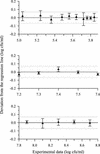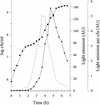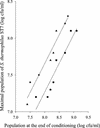Casein utilization by Streptococcus thermophilus results in a diauxic growth in milk
- PMID: 12039785
- PMCID: PMC123924
- DOI: 10.1128/AEM.68.6.3162-3165.2002
Casein utilization by Streptococcus thermophilus results in a diauxic growth in milk
Abstract
In milk, Streptococcus thermophilus displays two distinct exponential growth phases, separated by a nonexponential one, during which proteinase synthesis was initiated. During the second exponential phase, utilization of caseins as the source of amino acids resulted in a decrease in growth rate, presumably caused by a limiting peptide transport activity.
Figures




Similar articles
-
Accumulation of casein-derived peptides during growth of proteinase-positive strains of Lactococcus lactis in milk: their contribution to subsequent bacterial growth is impaired by their internal transport.J Dairy Res. 2000 May;67(2):233-40. doi: 10.1017/s0022029900004192. J Dairy Res. 2000. PMID: 10840677
-
Variability of hydrolysis of β-, αs1-, and αs2-caseins by 10 strains of Streptococcus thermophilus and resulting bioactive peptides.J Agric Food Chem. 2012 Jan 18;60(2):554-65. doi: 10.1021/jf202176d. Epub 2012 Jan 5. J Agric Food Chem. 2012. PMID: 22103626
-
[Isolation and amino acid composition of casein peptides stimulating growth if Streptococcus thermophilus].Eur J Biochem. 1972 Jul 13;28(2):190-8. doi: 10.1111/j.1432-1033.1972.tb01902.x. Eur J Biochem. 1972. PMID: 4677725 French. No abstract available.
-
Casein and peptide degradation in lactic acid bacteria.Biotechnol Genet Eng Rev. 1997;14:279-301. doi: 10.1080/02648725.1997.10647945. Biotechnol Genet Eng Rev. 1997. PMID: 9188156 Review. No abstract available.
-
Casein utilization by lactococci.Appl Environ Microbiol. 1991 Sep;57(9):2447-52. doi: 10.1128/aem.57.9.2447-2452.1991. Appl Environ Microbiol. 1991. PMID: 1768119 Free PMC article. Review. No abstract available.
Cited by
-
Mixed-culture transcriptome analysis reveals the molecular basis of mixed-culture growth in Streptococcus thermophilus and Lactobacillus bulgaricus.Appl Environ Microbiol. 2010 Dec;76(23):7775-84. doi: 10.1128/AEM.01122-10. Epub 2010 Oct 1. Appl Environ Microbiol. 2010. PMID: 20889781 Free PMC article.
-
A novel consortium of Lactobacillus rhamnosus and Streptococcus thermophilus for increased access to functional fermented foods.Microb Cell Fact. 2015 Dec 8;14:195. doi: 10.1186/s12934-015-0370-x. Microb Cell Fact. 2015. PMID: 26643044 Free PMC article.
-
Microcalorimetric study of the growth of Streptococcus thermophilus in renneted milk.Front Microbiol. 2015 Feb 10;6:79. doi: 10.3389/fmicb.2015.00079. eCollection 2015. Front Microbiol. 2015. PMID: 25713570 Free PMC article.
-
Proteomic Analysis of Lactobacillus nagelii in the Presence of Saccharomyces cerevisiae Isolated From Water Kefir and Comparison With Lactobacillus hordei.Front Microbiol. 2019 Feb 28;10:325. doi: 10.3389/fmicb.2019.00325. eCollection 2019. Front Microbiol. 2019. PMID: 30891008 Free PMC article.
-
The Joint Effect of pH Gradient and Glucose Feeding on the Growth Kinetics of Lactococcus lactis CECT 539 in Glucose-Limited Fed-Batch Cultures.Pol J Microbiol. 2019;68(2):269-280. doi: 10.33073/pjm-2019-030. Pol J Microbiol. 2019. PMID: 31257793 Free PMC article.
References
-
- Garault, P., D. Le Bars, and V. Monnet. 2001. Three binding proteins are involved in the transport of oligopeptide by Streptococcus thermophilus. J. Biol. Chem. 277:32-39. - PubMed
-
- Hassan, A. I., N. Deschamps, and J. Richard. 1989. Précision des mesures de vitesse de croissance des streptocoques lactiques dans le lait basées sur la méthode de dénombrement microbien par formation de colonies. Etude de référence avec Lactococcus lactis. Lait 69:433-447.
-
- Huggins, A. M., and W. E. Sandine. 1984. Differentiation of fast and slow milk-coagulating isolates in strains of lactic streptococci. J. Dairy Sci. 67:1674-1679.
Publication types
MeSH terms
Substances
LinkOut - more resources
Full Text Sources

